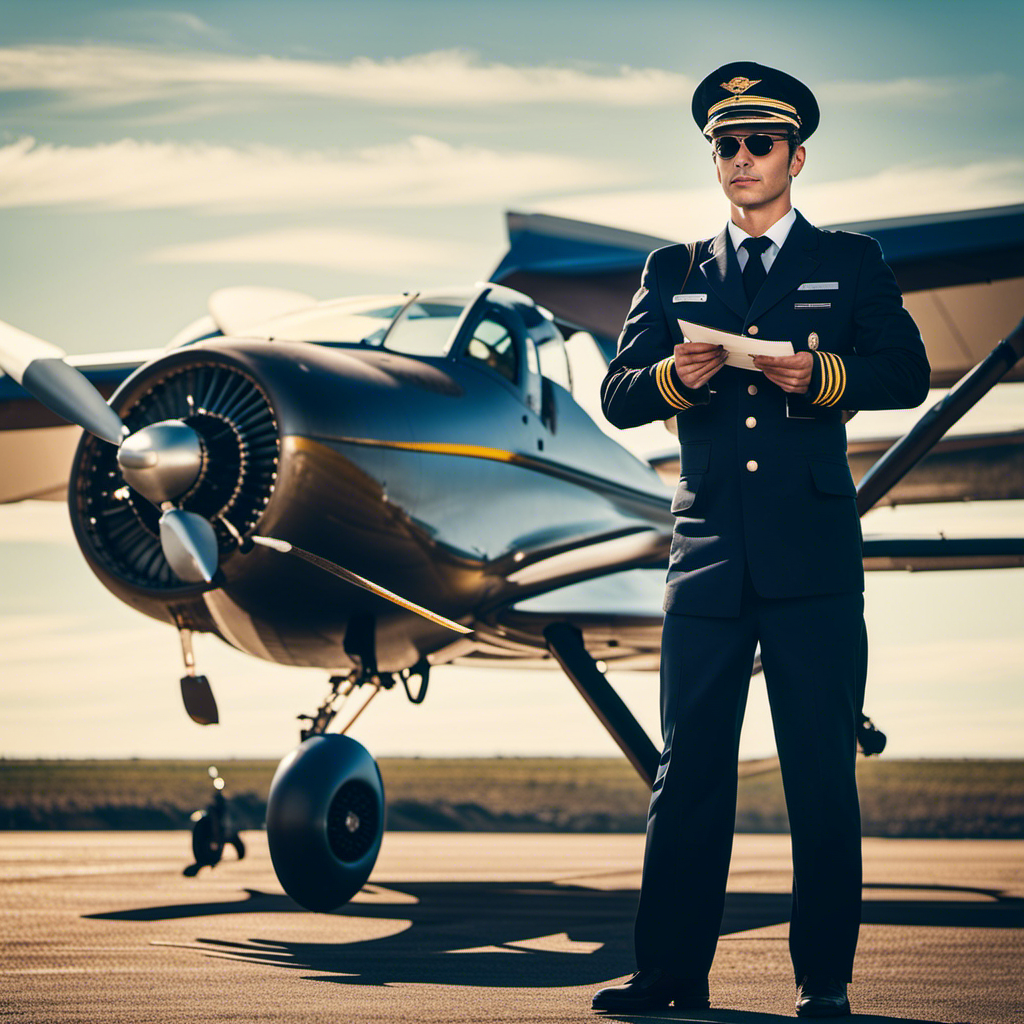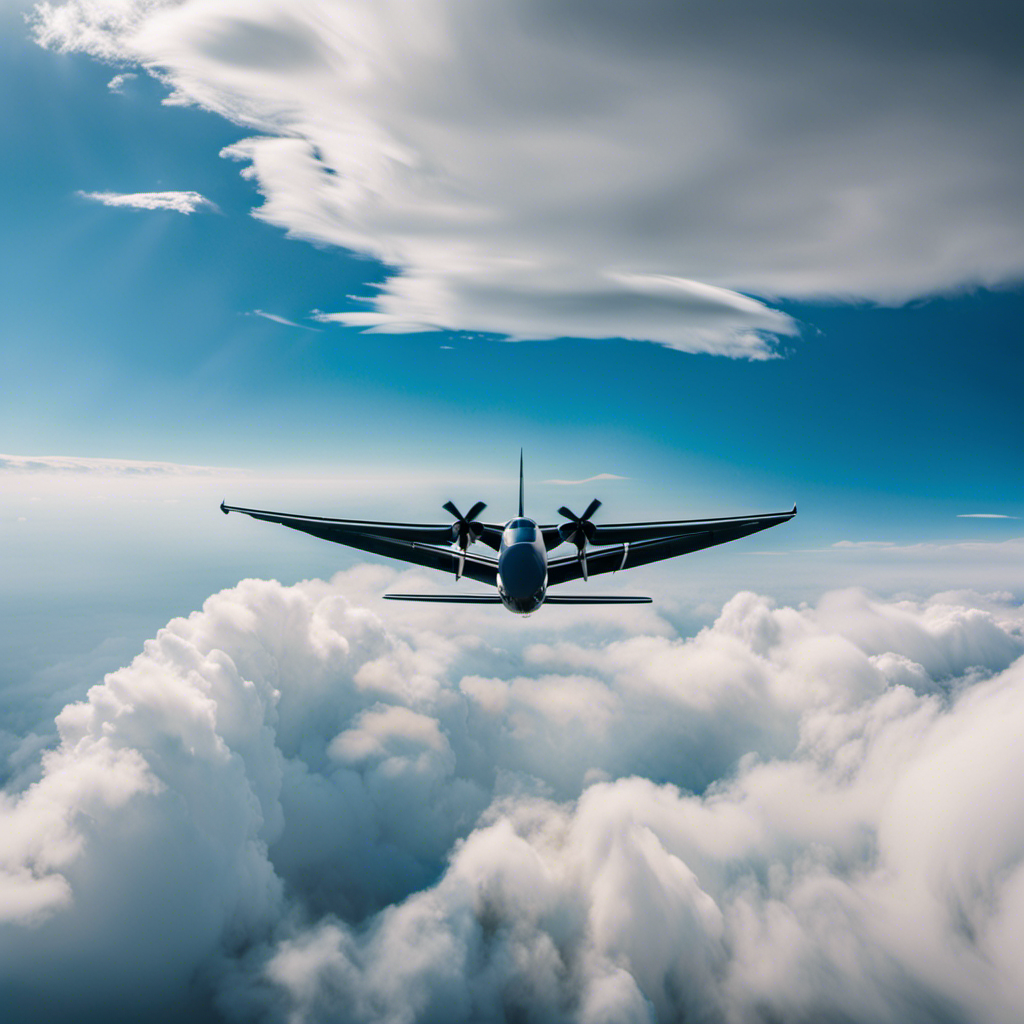You may be under the impression that the journey to becoming a pilot is intricate and intimidating. However, I can assure you, it need not be so.
In this comprehensive guide, I will walk you through everything you need to know about pilot licensing. From finding the right flight school to acing your flight exams, this article will provide you with all the information you need to obtain your permission to fly.
So, let’s dive in and embark on this exciting journey together.
Key Takeaways
- Different types of pilot licenses have different privileges and limitations, with private pilot licenses allowing personal flying and commercial pilot licenses required for flying commercially.
- Researching and selecting the right flight school is crucial for pursuing a career in aviation, considering factors such as reputation, programs, success rates, instructor compatibility, costs, accreditation, and training programs.
- Ground school, knowledge tests, and navigation are essential aspects of pilot training, with a focus on understanding aviation theory, regulations, pilot qualifications, weather conditions, and navigation using different instruments.
- Practical flight training, exams, and licensing are necessary steps in becoming a pilot, including familiarizing with aircraft controls, flight simulator training, learning emergency procedures, gaining hands-on flying experience, passing written exams, and completing a practical flight test. Continuing education and specializations can enhance expertise, and staying current and maintaining proficiency is important through ongoing education and training with flight simulators.
The Basics of Pilot Licensing
To become a licensed pilot, you’ll need to meet certain requirements and complete the necessary training. The cost of pilot licensing can vary depending on the type of license you want to obtain.
There are different types of pilot licenses, each with its own set of privileges and limitations. The most common type of license is the private pilot license, which allows you to fly for personal reasons but not for compensation. If you want to fly commercially, you’ll need to obtain a commercial pilot license, which requires additional training and experience. Transitioning from a private to a commercial license can be a significant step in a pilot’s career.
Once you’ve decided on the type of license you want, the next step is finding a flight school that meets your needs and goals.
Finding a Flight School
When it comes to pursuing a career in aviation, finding the right flight school is crucial. Researching flight schools is the first step in this process, allowing you to gather information about their reputation, programs, and success rates.
Once you have narrowed down your options, visiting and touring the flight schools will give you a firsthand experience of their facilities, aircraft, and overall atmosphere.
Lastly, choosing the right flight instructor is essential for your training journey, as their expertise, teaching style, and compatibility with your learning needs can greatly impact your progress and success as a pilot.
Researching Flight Schools
You should start by asking other pilots for recommendations on flight schools in your area. It’s important to gather as much information as possible before making a decision. When researching flight schools, there are a few key factors to consider: evaluating flight school costs and considering online flight training options. To help you compare different schools, here is a table that outlines some important aspects to consider:
| Aspect | Flight School A | Flight School B | Flight School C |
|---|---|---|---|
| Cost | $$$$ | $$$ | $ |
| Accreditation | Yes | Yes | No |
| Training Program | Full-time | Part-time | Online |
| Flight Simulators | Advanced | Basic | None |
| Instructor Experience | 10+ years | 5-10 years | 1-5 years |
Visiting and Touring Flight Schools
Take a moment to schedule visits at different flight schools in order to get a firsthand experience and see what each school has to offer.
Visiting flight schools and touring flight facilities is an essential step in the process of becoming a pilot. When you visit a flight school, you have the opportunity to meet with instructors, speak to current students, and observe the training environment.
Pay attention to the condition of the aircraft, the quality of the facilities, and the overall atmosphere of the school. Ask questions about the curriculum, the flight training process, and any additional services they offer.
Choosing the Right Flight Instructor
It’s important to consider the experience and qualifications of potential flight instructors when making your decision. Finding the right flight instructor is crucial to your success as a pilot. Here are three key factors to consider when evaluating flight instructor qualifications:
-
Expertise in your desired type of aircraft: Look for instructors who have experience and expertise in the type of aircraft you want to fly. They should be knowledgeable about the specific systems and procedures of that aircraft.
-
Teaching style and communication skills: A good flight instructor should be able to effectively communicate complex concepts and tailor their teaching style to your learning needs. Look for someone who is patient, encouraging, and able to adapt their teaching methods.
-
Safety record: Safety should always be a top priority. Research the safety record of potential flight instructors and inquire about their approach to safety during training.
By carefully considering these factors, you can choose the right flight instructor who will provide you with the necessary guidance and knowledge to become a skilled pilot.
Now let’s move on to the next section about ground school and knowledge tests.
Ground School and Knowledge Tests
When it comes to becoming a pilot, studying aviation theory is an essential part of the process. This involves learning about aerodynamics, weather patterns, and aircraft systems.
In addition to studying, aspiring pilots must also take knowledge tests to demonstrate their understanding of these concepts. These tests cover a wide range of topics, including navigation and airspace regulations, which are crucial for safe and efficient flight.
Studying Aviation Theory
To effectively study aviation theory, you should prioritize understanding key concepts and their practical applications. This will provide a solid foundation for your journey towards becoming a pilot.
When diving into aviation theory, keep in mind the following key points:
- Familiarize yourself with aviation regulations, as they are crucial to ensuring the safety and compliance of all flight operations.
- Gain a thorough understanding of pilot qualifications, which encompass the necessary skills, knowledge, and experience required to operate an aircraft.
- Explore the practical applications of aviation theory, such as understanding how weather conditions can impact flight operations and how to navigate using different instruments.
By delving into these topics, you will develop a comprehensive understanding of aviation theory, setting the stage for success in your knowledge tests.
This will be discussed further in the subsequent section.
Taking Knowledge Tests
After diligently studying aviation theory, it’s time to put your knowledge to the test. Taking knowledge tests is a crucial step towards obtaining your pilot’s license. But don’t worry, I’m here to provide you with some valuable preparation tips and test strategies.
Firstly, make sure you thoroughly review the relevant materials and study guides. Familiarize yourself with the topics that will be covered in the test and focus on understanding key concepts. Practice solving sample questions and take mock exams to gauge your progress.
During the test, manage your time wisely. Read each question carefully and avoid spending too much time on difficult ones. If you’re unsure about an answer, use the process of elimination to narrow down your options.
By following these preparation tips and test strategies, you can approach your knowledge tests with confidence and increase your chances of success.
Now, let’s delve into the next section, understanding navigation and airspace, where we’ll explore the intricacies of pilot navigation and the importance of airspace knowledge.
Understanding Navigation and Airspace
Now that you have a solid understanding of navigation and airspace, let’s dive into the intricacies of pilot navigation and the importance of airspace knowledge.
As a pilot, it’s crucial to have a comprehensive understanding of airspace regulations. These regulations dictate where and how you can fly, ensuring the safety and efficiency of air traffic.
Navigational instruments and technology play a vital role in pilot navigation. From traditional tools like compasses and maps to advanced GPS systems, pilots rely on these instruments to determine their position, plan routes, and make accurate course corrections. Mastering the use of these tools is essential for safe and effective navigation.
As we transition into the next section on practical flight training, you’ll see how all this knowledge and technology come together in real-world flying scenarios.
Practical Flight Training
Before you begin your practical flight training, it is important to familiarize yourself with the various aircraft controls. This will ensure that you have a solid foundation before taking to the skies. Here are four key aspects of practical flight training:
-
Flight simulator training: Utilizing a flight simulator allows you to practice flying in a controlled environment. This helps build muscle memory and improves your understanding of flight dynamics.
-
Emergency procedures training: It is crucial to be prepared for any unforeseen circumstances. Practical flight training includes learning how to handle emergency situations such as engine failures or loss of control.
-
Hands-on flying experience: Practical flight training involves getting behind the controls of an actual aircraft. You will learn how to take off, land, navigate, and perform various maneuvers.
-
Decision-making skills: Throughout your training, you will develop critical decision-making skills. This includes evaluating weather conditions, assessing risks, and making informed choices while flying.
As you progress through your practical flight training, you will gain the necessary skills and knowledge to pass your flight exams and checkrides, which we will discuss in the next section.
Flight Exams and Checkrides
As you progress through your practical flight training, it’s important to prepare for flight exams and checkrides to demonstrate your skills and knowledge.
Flight exam preparation is crucial to ensure success and confidence during these assessments. One common mistake students make is not dedicating enough time to study the required materials thoroughly. It’s essential to familiarize yourself with the regulations, procedures, and aircraft systems that will be assessed.
Another mistake is neglecting to practice the specific maneuvers and procedures that are typically evaluated during flight exams. Repetition and consistency are key to mastering these skills.
Additionally, staying calm and maintaining a clear head during the exam is vital. By avoiding these common mistakes and properly preparing, you can increase your chances of passing your flight exams and checkrides with flying colors.
Now, let’s move on to the next section about obtaining your pilot’s license.
Obtaining Pilot’s License
If you’re ready to earn your pilot’s license, it’s important to understand the requirements and steps involved. Here are four key things to consider when obtaining your pilot’s license:
-
Finding flight hours: To obtain a pilot’s license, you must log a certain number of flight hours. This can be done by taking lessons with a certified flight instructor or joining a flying club. It’s crucial to find opportunities to practice and gain experience in the air.
-
Obtaining a medical certificate: Before you can become a licensed pilot, you need to pass a medical examination and obtain a medical certificate. This ensures that you are physically fit to fly and meet the necessary health requirements.
-
Ground school and written exams: In addition to practical flight experience, you’ll need to complete ground school and pass written exams. These cover topics such as aviation regulations, aerodynamics, weather, and navigation. It’s important to study diligently and prepare for these exams.
-
Practical flight test: The final step towards obtaining your pilot’s license is the practical flight test, also known as the checkride. This test assesses your flying skills and knowledge of aviation procedures. Once you pass this test, you’ll be granted your pilot’s license.
With your pilot’s license in hand, you can now consider continuing education and specializations in the field of aviation, such as instrument rating or commercial pilot training. Taking these additional steps can further enhance your skills and open up new opportunities in your flying career.
Continuing Education and Specializations
Once you have your pilot’s license, you can consider pursuing further education and specializing in various areas of aviation. Continuing education options and specialized pilot certifications can help you expand your knowledge and skills, opening up new opportunities in the field of aviation. These additional certifications allow you to specialize in specific areas, such as instrument flying, aerobatics, or flight instruction. By obtaining these specialized certifications, you can enhance your expertise and become a more well-rounded and versatile pilot. Below is a table highlighting some of the continuing education options and specialized pilot certifications available:
| Continuing Education Options | Specialized Pilot Certifications |
|---|---|
| Flight Instructor Training | Instrument Rating |
| Aerobatics Training | Multi-Engine Rating |
| Aviation Management Courses | Commercial Pilot License |
| Aviation Safety Courses | Airline Transport Pilot License |
Staying Current and Maintaining Proficiency
To stay current and maintain proficiency in aviation, it is essential for pilots to continuously update their skills and knowledge through ongoing education and training. One effective way to achieve this is by maintaining currency through flight simulator training. Flight simulators provide pilots with a realistic environment to practice various scenarios and hone their skills. These simulators mimic the actual aircraft controls and systems, allowing pilots to familiarize themselves with different aircraft models and practice emergency procedures.
By regularly using flight simulators, pilots can stay up-to-date with the latest technology and procedures, ensuring they are prepared for any situation they may encounter in the air. Additionally, flight simulator training is a cost-effective alternative to practicing in an actual aircraft, making it more accessible for pilots to stay current with their training.
By incorporating flight simulator training into their ongoing education, pilots can enhance their proficiency and ensure they are well-prepared for their next flight.
Transition: In addition to maintaining currency through flight simulator training, another important aspect of staying current and connected in the aviation industry is joining aviation communities and organizations.
Joining Aviation Communities and Organizations
Making sure you stay current and proficient in your aviation skills is vital, but it’s equally important to connect with others in the industry. Joining aviation communities and organizations can provide numerous benefits, including networking opportunities and access to valuable resources. It allows you to interact with professionals who share your passion for aviation, opening doors to new opportunities and collaborations. To help you visualize the benefits of joining aviation communities, here’s a table showcasing some of the advantages:
| Benefits of Joining Aviation Communities and Organizations |
|---|
| Networking opportunities with industry professionals |
| Access to valuable resources and information |
| Sharing experiences and learning from others’ expertise |
| Discovering new career paths and job opportunities |
| Staying updated with industry news and developments |
Pursuing a Career in Aviation
By joining aviation communities and organizations, you can gain valuable insights and connections that can greatly benefit your career in aviation. Pursuing a career in aviation offers a wide range of exciting opportunities. Whether you dream of becoming a pilot, an aircraft mechanic, or working in aviation management, there are plenty of paths to choose from.
The aviation industry is constantly evolving, and being part of these communities ensures you stay up to date with the latest trends and advancements. Networking with professionals in the field can open doors to job opportunities that you may not have been aware of otherwise. Additionally, being part of these communities can provide valuable mentorship and guidance as you navigate your career.
When it comes to salary expectations, the aviation industry is known for its competitive compensation packages. Pilots, for example, can earn a substantial income, especially as they gain experience and move up in their careers. It’s important to research and understand the specific salary ranges for different positions within the industry to set realistic expectations for your career in aviation.
Frequently Asked Questions
What are the physical requirements for obtaining a pilot’s license?
To obtain a pilot’s license, I must meet certain physical requirements and undergo regular medical evaluations. These evaluations ensure that I am in good health and capable of safely operating an aircraft.
How long does it typically take to complete flight training and obtain a pilot’s license?
Flight training duration can vary depending on the individual’s dedication, skills, and the program they choose. On average, it takes around 6-12 months to complete flight training and obtain a pilot’s license.
Can I become a pilot if I wear glasses or have a history of vision problems?
Yes, you can become a pilot even if you wear glasses or have a history of vision problems. However, there are certain vision requirements that need to be met for pilot licensing.
Are there any age restrictions for obtaining a pilot’s license?
Yes, there are age restrictions for obtaining a pilot’s license. The minimum age for a private pilot license is 17, while the minimum age for a commercial pilot license is 18. Additionally, there are medical requirements that must be met.
Is there financial assistance available for flight training and obtaining a pilot’s license?
Financial assistance options such as scholarships and grants are available for flight training and obtaining a pilot’s license. Did you know that 85% of pilots who receive financial aid successfully complete their training?
Conclusion
In conclusion, obtaining a pilot license is a journey that requires dedication, perseverance, and a thirst for knowledge.
Just like a bird soaring through the sky, you too can spread your wings and reach new heights in the aviation world.
Remember, the sky is not the limit, but rather a canvas for your dreams to take flight.
So embrace the challenges, stay current, and continue to learn and grow.
Fly high and never stop reaching for the stars!
With a heart that soars as high as the skies, Aria, affectionately known as “Skylark,” is the driving force behind Soaring Skyways. Her journey into the gliding world began as a young dreamer gazing up at the soaring birds, yearning to experience the weightlessness and freedom they embodied. With years of experience both in the cockpit and behind the scenes, Aria’s commitment to the gliding community is unwavering.










